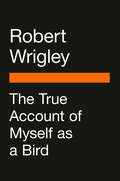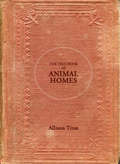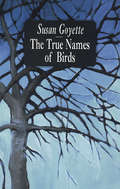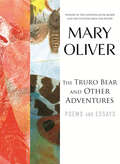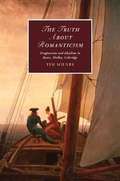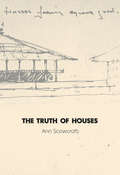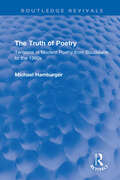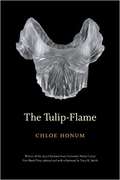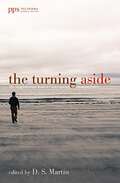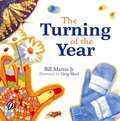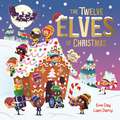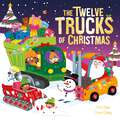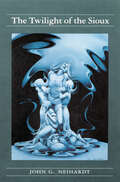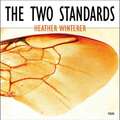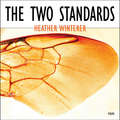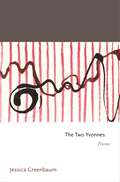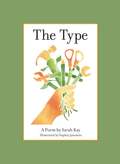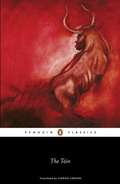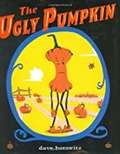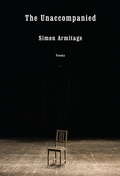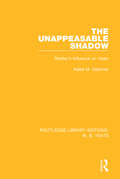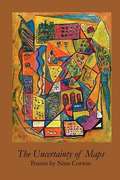- Table View
- List View
The True Account of Myself as a Bird (Penguin Poets)
by Robert WrigleyFrom an award-winning poet, a new collection that endeavors to pass along what the things of the earth are telling usOver the course of his career Robert Wrigley has won acclaim for the emotional toughness, sonic richness, and lucid style of his poems, and for his ability to fuse narrative and lyrical impulses. In his new collection, Wrigley means to use poetry to capture the primal conversation between human beings and the perilously threatened planet on which they love and live, proceeding from a line from Auden: &“All we are not stares back at what we are.&” In language that is both elegiac and playful, declarative and yet ringingly musical; in traditional sonnets, quatrains, and free verse, Wrigley transcribes the consciousness and significance of every singing thing—in order to sing back.
The True Book of Animal Homes
by Allison TitusAllison Titus reveals the animal in the human, and the human in the animal. Allison Titus’s newest poetry collection, The True Book of Animal Homes, is obsessed with animal and human alike, and how each one of us makes our home in the stations we hold—from the wilds of southern brambles to a desk in an office cubicle. This book ponders the question: how much wildness are we allowed in this life, and how do we claim that wildness? The poems of The True Book of Animal Homes leap and scurry after the truth on all fours, devouring us with sharp language and brave new forms.
The True Names of Birds
by Sue GoyetteNominated for the 1999 Governor General's Award for Poetry, the 1999 Pat Lowther Award and the 1999 Gerald Lampert Award and Globe 100 book for 1999 The True Names of Birds is the first book-length collection from a voice that has captured the attention of Canadian poetry readers for the last half-dozen years. Deeply centred in domestic life, Goyette's work is informed by a muscular lyricism. These are poems that push the limits, always true to their roots.
The Truro Bear and Other Adventures: Poems and Essays
by Mary OliverThe Truro Bear and Other Adventures, a companion volume to Owls and Other Fantasies and Blue Iris, brings together ten new poems, thirty-five of Oliver's classic poems, and two essays all about mammals, insects, and reptiles. The award-winning poet considers beasts of all kinds: bears, snakes, spiders, porcupines, humpback whales, hermit crabs, and, of course, her beloved but disobedient little dog, Percy.
The Truth Is Told Better This Way
by Liz WorthPulling from raw themes of grief and death, regret and discomfort, sadness and failure, Worth wears these poems down to their bones. Straddling dreamy, ethereal images and brutal honesty, The Truth is Told Better This Way unravels its secrets one line at a time. The result is oracular and surreal, as each piece could be read as a magic spell that mesmerizes as much as a poem that tantalizes the senses.
The Truth about Romanticism
by Tim MilnesHow have our conceptions of truth been shaped by romantic literature? This question lies at the heart of this examination of the concept of truth both in romantic writing and in modern criticism. The romantic idea of truth has long been depicted as aesthetic, imaginative, and ideal. Tim Milnes challenges this picture, demonstrating a pragmatic strain in the writing of Keats, Shelley and Coleridge in particular, that bears a close resemblance to the theories of modern pragmatist thinkers such as Donald Davidson and J8rgen Habermas. Romantic pragmatism, Milnes argues, was in turn influenced by recent developments within linguistic empiricism. This book will be of interest to readers of romantic literature, but also to philosophers, literary theorists, and intellectual historians.
The Truth of Houses
by Ann ScowcroftWinner of the 2011 Concordia University First Book Prize, Quebec Writers' Federation Literary Awards Poems exploring the idea of home and the difficulties of a deeply ambiguous relationship to that word. At once wise and achingly at a loss, Ann Scowcroft's The Truth of Houses is an elegant debut collection. While very intimate -- even startlingly intimate at times -- the voices of these poems are constantly taking a step backward, wrestling for a measure of distance and perspective. Reading them, we eavesdrop on the uncovering of a personal vernacular that might allow the present to be better lived; we have the sense of overhearing a particular yet eerily familiar inner struggle -- a struggle for insight, for an equanimity with which both narrator and fortunate reader might re-enter life anew.
The Truth of Poetry: Tensions in Modern Poetry from Baudelaire to the 1960s (Routledge Revivals)
by Michael HamburgerFirst published in 1982, The Truth of Poetry attempts to answer a seemingly simple question: What kind of truth does poetry offer in modern times? Michael Hamburger’s answer to this question ranges over the last century of European and American poetry, and the result is a phenomenology of modern poetry rather than a history of appreciations of individual poets. Stressing the tensions and conflicts in and behind the work of every major poet of the period, he considers the many different possibilities open to poets since Baudelaire. This expansive work of analysis will be of interest to students of English literature, poetry enthusiasts and literary historians.
The Tulip-Flame
by Chloe HonumTHE TULIP-FLAME traces an identity forming within radically divergent but interlocking systems: a family traumatized by the mother's suicide, a failed relationship, the practice of ballet, a garden.
The Turning Aside: The Kingdom Poets Book of Contemporary Christian Poetry (Poiema Poetry)
by D. S. MartinThe Turning Aside is about stepping out of our routines--like Moses turning from tending sheep, like a certain man selling his everything to buy a field--to take time to consider the ways of God in the company of some of the finest poets of our time. Turn aside with such established poets as Wendell Berry, Les Murray, Luci Shaw, Elizabeth Jennings, Richard Wilbur, Dana Gioia, and Christian Wiman--and respond to their invitation for us to muse along with them. Walk with poets from various parts of the planet, even though some of them are less known, whose words have been carefully crafted to encourage us in our turning aside. The Turning Aside is a collection of Christian poetry from dozens of the most spiritually insightful poetic voices of recent years. It is a book I have long dreamed of compiling, and it has grown beyond my mere imagining in its fulfillment.
The Turning of the Year
by Billy MartinSledding, splashing, catching fireflies, picking pumpkins--there's always something fun to do outdoors.
The Twelve Elves of Christmas
by Evie DayOn the first day of Christmas Santa asked, "Who's helping me?"I told him . . . "Leave everything to me and Elfie!"Count and sing along as more and more elves join in helping Santa with his festive jobs over the twelve days of Christmas! From three selfie-elfies snapping photos in Santa's grotto to five twinkling elves hanging lights to nine elves brushing the reindeer... and Santa's beard! An elf-filled twist on the infamous 'Twelve Days of Christmas' carol, this hilarious festive romp is the perfect book to share and read together.
The Twelve Trucks of Christmas
by Evie DayOn the first day of Christmas, Santa said: "I need . . . To build a land so very-merryyyy!"Count and sing along as all of Santa's trucks get to work to help build a very merry winter wonderland, just in time for Christmas! Hop on for this festive adventure and spot magic-mixers, jingle-scoopers and more . . . A twist on the infamous 'Twelve Days of Christmas' carol with TRUCKloads of fun, this hilarious festive romp will have little ones laughing and singing along in no time!
The Twilight of the Sioux (Volume II of A Cycle of the West)
by John G. NeihardtThe second volume of A Cycle of the West, dealing with the tragic defeat of the Plains Indians, includes The Song of the Indian Wars (1925) and The Song of the Messiah (1935). The former tells of "the period of migration and the last great fight for the bison pastures between the invading white race and the Sioux, the Cheyenne, and the Arapahoe," while the latter concerns "the conquered people and the worldly end of the last great dream." It closes with the battle of Wounded Knee, ending Indian resistance on the Plains.
The Two Sillies
by Mary Anne Hoberman Lynne CravathTold in rhyme, the story is of two silly people and the way in which they help each other get a pet cat and get rid of mice.
The Two Standards
by Heather WintererHeather Winterer explores the intimate territory between desolation and consolation, offering a poetry that translates the distances between spiritual endings and beginnings, between an "after what it used to be" and "an arrival". The work enacts the model of St Ignatius Loyola, encouraging the collapse of lines between creation and creativity, time and space, the Christian and Christ, the self and the other. The voice of these poems moves exuberantly through various forms, resisting predication and celebrating its own multiplicity. With lyrical dexterity and humour, Winterer invites us into her world, a world of tangible absences and presences -- where the Mojave Desert and the city of Las Vegas become the unlikely sites of spiritual encounter. The god of this quirky world appears in cars, apartment buildings, and swimming pools and speaks to us through desert plants and birds. Everything from the outside -- natural and unnatural -- spills into the poems and they turn whatever they are given into movement away from darkness and loss, toward possibility, potency and grace.
The Two Standards (Mountain West Poetry Series)
by Heather WintererHeather Winterer explores the intimate territory between desolation and consolation, offering a poetry that translates the distances between spiritual endings and beginnings, between an "after what it used to be" and "an arrival." The work enacts the model of St. Ignatius Loyola, encouraging the collapse of lines between creation and creativity, time and space, the Christian and Christ, the self and the other. The voice of these poems moves exuberantly through various forms, resisting predication and celebrating its own multiplicity. With lyrical dexterity and humor, Winterer invites us into her world, a world of tangible absences and presences--where the Mojave Desert and the city of Las Vegas become the unlikely sites of spiritual encounter. The god of this quirky world appears in cars, apartment buildings, and swimming pools and speaks to us through desert plants and birds. Everything from the outside--natural and unnatural--spills into the poems and they turn whatever they are given into movement away from darkness and loss, toward possibility, potency and grace.
The Two Yvonnes: Poems (Princeton Series of Contemporary Poets #61)
by Jessica GreenbaumThis is the second collection from a Brooklyn poet whose work many readers will know from the New Yorker. Jessica Greenbaum's narrative poems, in which objects and metaphor share highest honors, attempt revelation through close observation of the everyday. Written in "plain American that cats and dogs can read," as Marianne Moore phrased it, these contemporary lyrics bring forward the challenges of Wisława Szymborska, the reportage of Yehuda Amichai, and the formal forays of Marilyn Hacker. The book asks at heart: how does life present itself to us, and how do we create value from our delights and losses? Riding on Kenneth Koch's instruction to "find one true feeling and hang on," The Two Yvonnes overtakes the present with candor, meditation, and the classic aspiration to shape lyric into a lasting force.Moving from 1960s Long Island, to 1980s Houston, to today's Brooklyn, the poems range in subject from the pages of the Talmud to a squirrel trapped in a kitchen. One tells the story of young lovers "warmed by the rays / Their pelvic bones sent over the horizon of their belts," while another describes the Bronx Zoo in winter, where the giraffes pad about "like nurses walking quietly / outside a sick room." Another poem defines the speaker via a "packing slip" of her parts--"brown eyes, brown hair, from hirsute tribes in Poland and Russia." The title poem, in which the speaker and friends stumble through a series of flawed memories about each other, unearths the human vulnerabilities that shape so much of the collection.From The Two Yvonnes:WHEN MY DAUGHTER GOT SICKHer cries impersonated all the world;The fountain's bubbling speech was just a trickBut still I turned and looked, as she implored,Or leaned toward muffled noises through the bricks:Just radio, whose waves might be her wav-ering, whose pitch might be her quavering,I turned toward, where, the sirens might be "SaveMe," "Help me," "Mommy, Mommy"—everythingShe, too, had said, since sloughing off the world.She took to bed, and now her voice stays fusedTo air like outlines of a bygone girl;The streets, the lake, the room—just places bruisedWithout her form, the way your sheets still holdRough echoes of the risen sleeper, cold.
The Type
by Sarah KaySarah Kay's powerful spoken word poetry performances have gone viral, with more than 10 million online views and thousands more in global live audiences. In her second single-poem volume, Kay takes readers along a lyrical road toward empowerment, exploring the promise and complicated reality of being a woman. During her spoken word poetry performances, audiences around the world have responded strongly to Sarah Kay's poem The Type. As Kay wrote in The Huffington Post: "Much media attention has been paid to what it means to 'be a woman,' but often the conversation focuses on what it means to be a woman in relation to others. I believe these relationships are important. I also think it is possible to define ourselves solely as individuals... We have the power to define ourselves: by telling our own stories, in our own words, with our own voices."Never-before-published in book form, The Type is illustrated throughout and perfect for gift-giving.
The Táin: A New Translation of the Táin Bó Cúailnge
by Ciaran CarsonFor jealousy of her husband's prize bull, Medb, Queen of Connacht, takes her people to war to steal its match from Ulster -- the legendary Brown Bull of Cuailnge. With the Ulsterman stricken by a curse, only the youthful Cu Chulainn stands against Connacht's assembled armies, but in feats of supernatural strength and extravagant violence, he sets about bloodily disassembling them.<P> Full of black comedy and brutal action, The Tain is the great epic of Irish folk literature, and Ciaron Carson's translation perfectly captures its excitement, humour and earthiness.
The Ugly Pumpkin
by Dave HorowitzWith looks different than all the others in the pumpkin patch, Ugly Pumpkin is teased by his peers and never gets picked throughout the whole season, but after he leaves the patch and heads out on his own, Ugly Pumpkin discovers that he is special in his own way and ends up becoming the star of a wonderful Thanksgiving celebration!
The Unaccompanied: Poems
by Simon ArmitageA powerful new collection of poetry from the National Book Critics Circle Award nominee and recipient of the Forward Poetry Prize In The Unaccompanied, Armitage gives voice to the people of Britain with a haunting grace. We meet characters whose sense of isolation is both emotional and political, both real and metaphorical, from a son made to groom the garden hedge as punishment, to a nurse standing alone at a bus stop as the centuries pass by, to a latter-day Odysseus looking for enlightenment and hope in the shadowy underworld of a cut-price supermarket. We see the changing shape of England itself, viewed from a satellite "like a shipwreck's carcass raised on a sea-crane's hook, / nothing but keel, beams, spars, down to its bare bones." In this exquisite collection, Armitage X-rays the weary but ironic soul of his nation, with its "Songs about mills and mines and a great war, / lines about mermaids and solid gold hills, / songs from broken hymnbooks and cheesy films"--in poems that blend the lyrical and the vernacular, with his trademark eye for detail and biting wit.From the Hardcover edition.
The Unappeasable Shadow: Shelley's Influence on Yeats (Routledge Library Editions: W. B. Yeats #3)
by Adele M. DalsimerYeats and his shadow are one of the most closely scrutinised pairs in contemporary literary history. The meaning and significance Yeats gave to the entity by which he was constantly pursued and with which he held frequent colloquy have been held under the critical microscope, and the shadow has emerged alternately as the course of human history, the poet’s alter-ego, his inner self, the natural man, or as anything that Yeats wanted but believed himself not to be. This title, first published in 1988, examines the influence that Shelley had on Yeats and this ‘shadow’. The study concentrates primarily on the complex influence of Shelley’s Alastor on Yeats, tracing the problems it suggests and the questions it raises from Yeats’s early, highly imitative poems through the austere, unromantic middle poems to the late poems where Yeats sees himself as the "last of the romantics". This title will be of interest to students of literature.
The Unbeatable Bread
by Lyn Littlefield HoopesThe aroma of a special bread subdues the effects of a harsh winter and draws people and animals to unite in a fabulous feast.
The Uncertainty Of Maps
by Nina CorwinCollection of poems dealing with language, contemporary life, and identity. Corwin's work has been published in Atlanta Review, Kalliope, Nimrod International Journal of Prose and Poetry, and many other periodicals.
